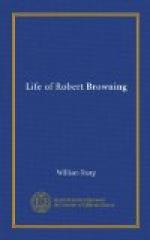Browning was visiting Pornic one autumn, when he saw the gipsy who was the original of “Fifine.” In the words of Mrs. Orr, “his fancy was evidently set roaming by the gipsy’s audacity, her strength—the contrast which she presented to the more spiritual types of womanhood; and this contrast eventually found expression in a pathetic theory of life, in which these opposite types and their corresponding modes of attraction became the necessary complement of each other. As he laid down the theory, Mr. Browning would be speaking in his own person. But he would turn into some one else in the act of working it out—for it insensibly carried with it a plea for yielding to those opposite attractions, not only successively, but at the same time; and a modified Don Juan would grow up under his pen.”
One drawback to an unconditional enjoyment of Balzac is that every now and again the student of the Comedie Humaine resents the too obvious display of the forces that propel the effect—a lesser phase of the weariness which ensues upon much reading of the mere “human documents” of the Goncourt school of novelists. In the same way, we too often see Browning working up the electrical qualities, so that, when the fulmination comes, we understand “just how it was produced,” and, as illogically as children before a too elaborate conjurer, conclude that there is not so much in this particular poetic feat as in others which, like Herrick’s maids, continually do deceive. To me this is affirmable of “Fifine at the Fair.” The poet seems to know so very well what he is doing. If he did not take the reader so much into his confidence, if he would rely more upon the liberal grace of his earlier verse and less upon the trained subtlety of his athletic intellect, the charm would be the greater. The poem would have a surer duration as one of the author’s greater achievements, if there were more frequent and more prolonged insistence on the note struck in the lines (Sec. lxxiii.) about the hill-stream, infant of mist and dew, falling over the ledge of the fissured cliff to find its fate in smoke below, as it disappears into the deep, “embittered evermore, to make the sea one drop more big thereby:” or in the cloudy splendour of the description of nightfall (Sec. cvi.): or in the windy spring freshness of
“Hence, when the
earth began afresh its life in May,
And fruit-trees
bloomed, and waves would wanton, and the bay
Ruffle its wealth
of weed, and stranger-birds arrive,
And beasts take
each a mate.” ...
But its chief fault seems to me to be its lack of that transmutive glow of rhythmic emotion without which no poem can endure. This rhythmic energy is, inherently, a distinct thing from intellectual emotion. Metric music may be alien to the adequate expression of the latter, whereas rhythmic emotion can have no other appropriate issue. Of course, in a sense, all creative art is rhythmic in kind:




